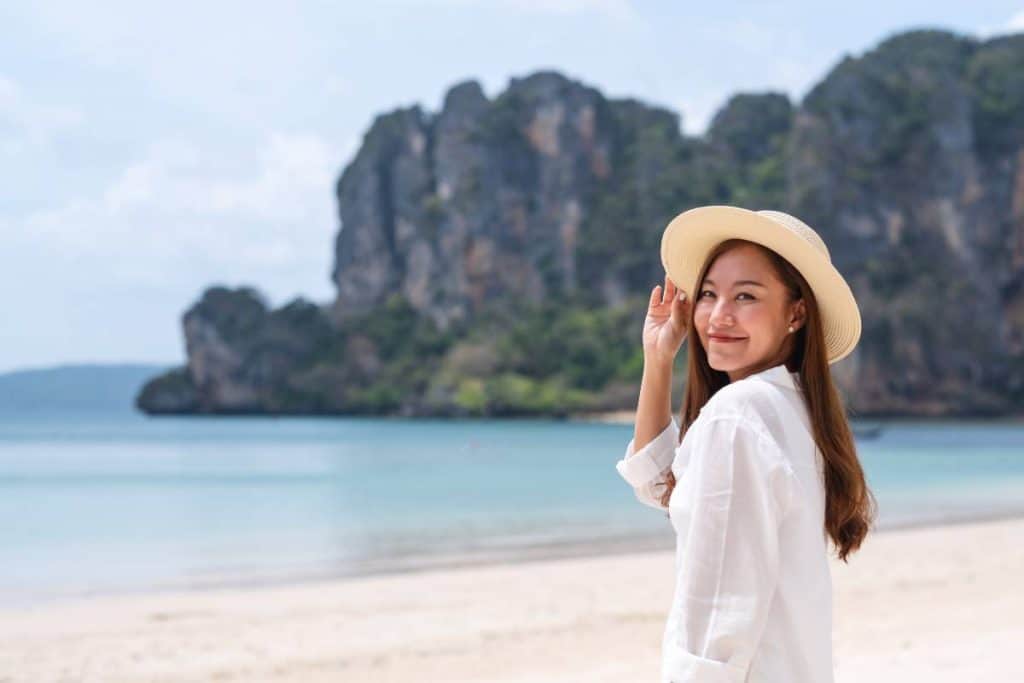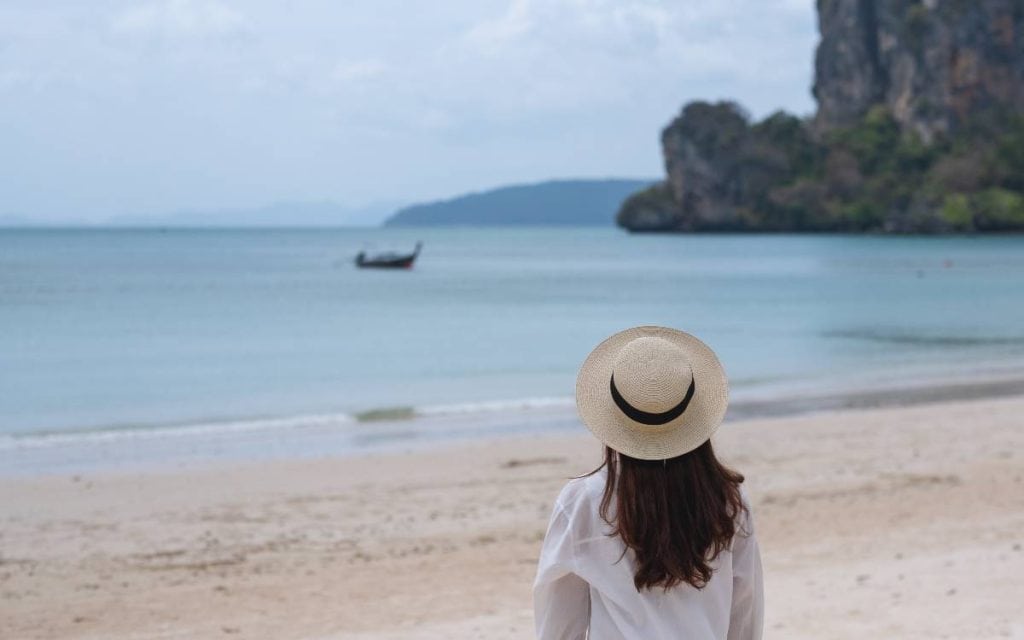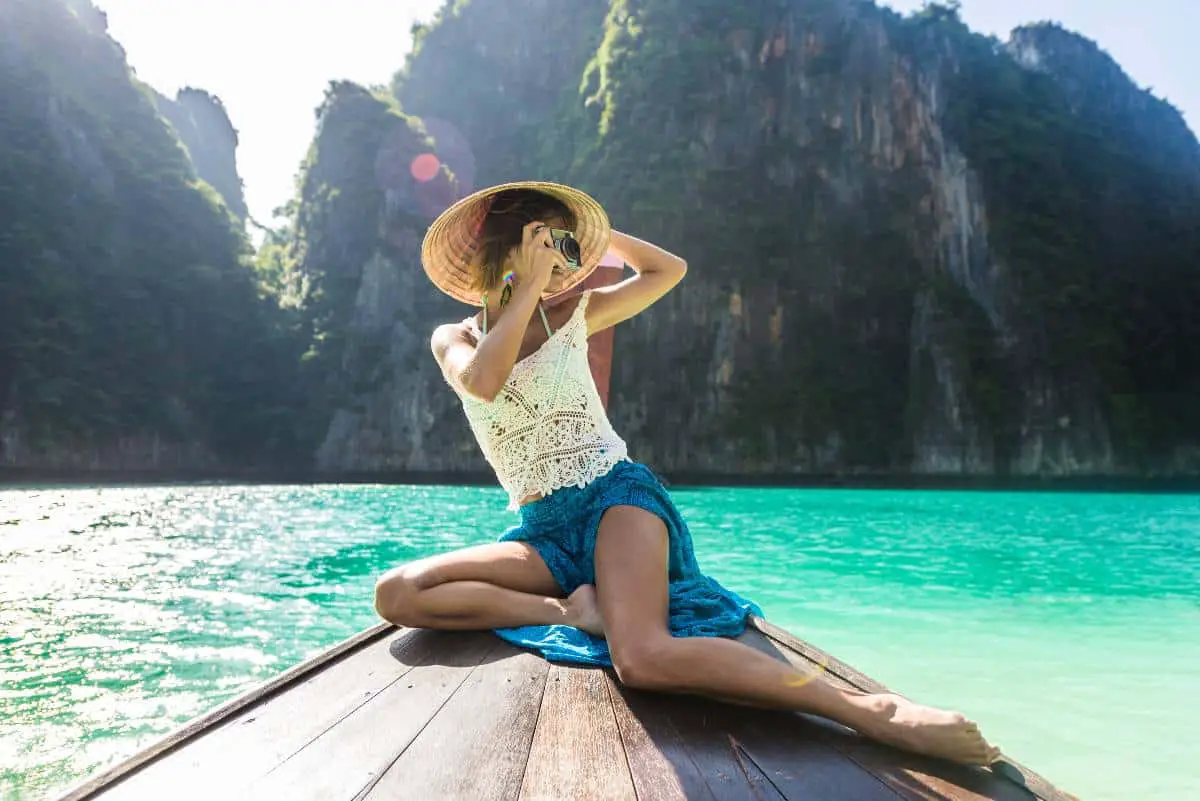Sun Exposure Tips In Thailand You Should Know
Welcome to Thailand, the Land of Smiles! As living in this beautiful country, I’ve come to appreciate the importance of sun protection. Thailand’s tropical climate and high UV index can put your skin at risk if you’re not careful. At BetterLivingAsia.com, our goal is to help you enjoy your time in Thailand while keeping your skin healthy and happy. In this guide, we’ll share essential sun exposure tips to help you navigate Thailand’s intense sun and make the most of your experience. Whether you’re here to retire, work, or start a business, protecting your skin is crucial for your overall health and well-being. So, let’s dive in and discover how to stay sun-safe in Thailand!
Key Takeaways
- Thailand’s tropical climate and high UV index make sun protection crucial for health and well-being
- Choosing the right sunscreen, wearing protective clothing, and adapting to outdoor activities are key to staying safe in the sun
- Staying hydrated, understanding environmental factors, and being aware of Thai cultural attitudes toward sun exposure can enhance your travel experience
Understanding Thailand’s UV Index
Before we get into the nitty-gritty of sun protection, let’s talk about Thailand’s UV index. The UV index is a scale that measures the intensity of the sun’s ultraviolet radiation. In Thailand, the average UV index rating is relatively high, ranging from 7 to 14 depending on the time of year and location.
Some of the high UV index provinces in Thailand include:
- Chonburi (Pattaya)
- Phuket
- Krabi
- Surat Thani (Koh Samui)
It’s important to note that UV levels can vary throughout the day and year. The sun’s rays are strongest between 10 am and 4 pm, and the UV index tends to be higher during the dry season (November to April).
Understanding Thailand’s UV index is the first step in protecting your skin. By being aware of the UV levels in your area and taking appropriate precautions, you can minimize your risk of sun damage and enjoy your time in Thailand to the fullest.
Sunscreen: Your First Line of Defense
When it comes to sun protection, sunscreen is your best friend. But with so many options out there, how do you choose the right one? Let’s break it down.
First, look for a sunscreen with a high SPF rating (at least 30) and a PA rating of +++ or ++++. SPF measures protection against UVB rays, while PA measures protection against UVA rays.
There are two main types of sunscreen: physical and chemical. Physical sunscreens contain ingredients like zinc oxide or titanium dioxide that sit on top of your skin and deflect UV rays. Chemical sunscreens, on the other hand, contain ingredients that absorb UV rays before they can damage your skin.
When choosing a sunscreen, consider your skin type. If you have oily or acne-prone skin, look for a lightweight, oil-free formula. If you have dry or sensitive skin, opt for a moisturizing formula with soothing ingredients like aloe vera or chamomile.
Now, let’s talk sunscreen application. Here are some tips:
- Apply sunscreen 20-30 minutes before sun exposure
- Use enough to cover all exposed areas (about 1 ounce for your entire body)
- Reapply every 2 hours or after swimming or sweating
- Don’t forget to apply sunscreen to often-missed spots like your ears, neck, and feet
It’s also important to remember that sunscreen has limitations. No sunscreen can block 100% of UV rays, and factors like sweat, water, and friction can reduce its effectiveness. That’s why it’s crucial to combine sunscreen with other sun protection measures, which we’ll cover in the next section.
Sun-Protective Clothing and Accessories
In addition to sunscreen, wearing sun-protective clothing and accessories can provide an extra layer of defense against UV rays. Look for clothing with a high UPF rating, which measures the amount of UV radiation that can penetrate the fabric.
When choosing sun-protective clothing, opt for:
- Lightweight, breathable fabrics like cotton or linen
- Dark colors, which offer more protection than light colors
- Tightly woven fabrics, which provide better protection than loosely woven fabrics
- Long-sleeved shirts and pants
Don’t forget about sun-protective accessories like:
- Wide-brimmed hats to protect your face, ears, and neck
- Sunglasses with UV protection to shield your eyes from sun damage
- UV-resistant umbrellas to provide shade when you’re out and about
When it comes to swimwear, look for options with built-in sun protection. Many brands now offer swimsuits and rash guards with UPF ratings of 50 or higher.
Remember, sun-protective clothing and accessories are not a substitute for sunscreen. Instead, they should be used in combination with sunscreen to provide the best possible protection against UV rays. By wearing sun-protective clothing and accessories, you can enjoy your favorite outdoor activities in Thailand while minimizing your risk of sun damage.

Adapting Your Outdoor Activities
Thailand’s tropical climate and beautiful beaches make it a popular destination for outdoor activities. However, it’s important to adapt your outdoor plans to minimize sun exposure and stay safe.
One of the most important things to keep in mind is the timing of your activities. As we mentioned earlier, the sun’s rays are strongest between 10 am and 4 pm. If possible, plan your outdoor activities for early morning or late afternoon when the sun is less intense.
When you are outdoors, seek shade whenever possible. This can include staying under umbrellas or trees or taking breaks in air-conditioned spaces.
If you’re planning a beach day or water activities, be extra vigilant about sun protection. Sand and water can reflect UV rays, increasing your exposure. Make sure to apply sunscreen frequently and wear sun-protective clothing and accessories.
When planning your itinerary, consider indoor activities during peak sun hours. Visit museums, temples, or shopping malls to stay cool and protected from the sun.
By adapting your outdoor activities and being mindful of sun exposure, you can still enjoy all that Thailand has to offer while keeping your skin safe and healthy.
Sun Protection for Specific Groups
While everyone needs sun protection, some groups may require extra care and attention. Let’s take a look at some specific considerations for different groups.
Infants and Children
Infants under six months should be kept out of direct sunlight as much as possible. For older infants and children, use a broad-spectrum sunscreen with an SPF of at least 30 and reapply every two hours. Dress children in sun-protective clothing and hats, and encourage them to play in the shade.
People with Sensitive Skin or Sun Allergies
If you have sensitive skin or a sun allergy, you may need to take extra precautions. Look for sunscreens designed for sensitive skin, and consider using physical sunscreens instead of chemical ones. Wear sun-protective clothing and accessories, and limit your time in direct sunlight.
Individuals with Pre-Existing Skin Conditions
If you have a pre-existing skin condition like acne, rosacea, eczema, or psoriasis, sun exposure can sometimes exacerbate your symptoms. Talk to your dermatologist about the best sun protection strategies for your specific condition. They may recommend specific sunscreen ingredients or additional protective measures.
Sun Protection for Tattoos
If you have tattoos, it’s important to protect them from sun damage. UV rays can cause tattoos to fade or blur over time. Use a broad-spectrum sunscreen with an SPF of at least 30 on your tattoos, and consider covering them with sun-protective clothing when possible.
Sun Safety for Older Adults and Medication Interactions
As we age, our skin becomes more susceptible to sun damage. Older adults should be especially diligent about sun protection, using sunscreen and wearing protective clothing and accessories. It’s also important to be aware of any medications you’re taking that may increase your sensitivity to the sun. Talk to your doctor or pharmacist about potential interactions and take appropriate precautions.
After-Sun Care and Treating Sunburns
Despite our best efforts, sometimes sunburns happen. If you find yourself with a sunburn, it’s important to take steps to soothe your skin and promote healing.
Symptoms of sunburn can include:
- Red, warm, or tender skin
- Swelling
- Blistering (in severe cases)
To soothe sunburned skin, try the following:
- Take a cool bath or shower
- Apply a cool compress to the affected area
- Use a moisturizer with aloe vera or soy to help soothe the skin
- Take an over-the-counter pain reliever like ibuprofen or acetaminophen to help with pain and inflammation
- Drink plenty of water to stay hydrated
If your sunburn is severe or blistering, or if you experience symptoms like fever, chills, or dizziness, seek medical attention.
In Thailand, there are also some traditional remedies for sunburned skin. Aloe vera, which grows abundantly in Thailand, is a popular choice for soothing sunburns. Some people also use coconut oil or cold compress with cucumber slices to help cool and soothe the skin.
Remember, the best treatment for sunburn is prevention. By protecting your skin with sunscreen, protective clothing, and smart sun habits, you can minimize your risk of sunburn and enjoy your time in Thailand worry-free.
Staying Hydrated and Preventing Heat-Related Illnesses
Thailand’s hot and humid climate can put you at risk for dehydration and heat-related illnesses like heat exhaustion and heatstroke. To stay safe and healthy, it’s important to stay hydrated and take steps to prevent overheating.
Signs of dehydration can include:
- Thirst
- Dry mouth or lips
- Dizziness or lightheadedness
- Dark yellow urine
To stay hydrated, make sure to drink plenty of water throughout the day. Aim for at least 8-10 glasses of water per day, and more if you’re spending time outdoors or exercising. You can also stay hydrated by consuming hydrating foods like watermelon, cucumber, and coconut water.
In addition to staying hydrated, there are other strategies for staying cool in Thailand’s heat. These include:
- Wearing lightweight, breathable clothing
- Staying in air-conditioned spaces during peak sun hours
- Using fans or misting sprays to cool down
- Taking cool showers or baths
If you experience symptoms of heat exhaustion like heavy sweating, dizziness, or nausea, it’s important to get to a cool place and hydrate immediately. If symptoms persist or worsen, seek medical attention.
By staying hydrated and taking steps to prevent overheating, you can enjoy your time in Thailand while staying safe and healthy.
Environmental Factors and Sun Protection
Thailand’s environment can present some unique challenges when it comes to sun protection. Let’s take a look at some of the environmental factors to consider.
Air pollution can actually increase your risk of sun damage. Pollutants in the air can weaken the ozone layer, which normally helps to filter out harmful UV rays. In cities like Bangkok, where air pollution can be high, it’s especially important to protect your skin with sunscreen and protective clothing.
Urban environments can also increase your sun exposure. Reflective surfaces like concrete and glass can bounce UV rays back onto your skin, increasing your risk of sun damage. If you’re spending time in urban areas, be sure to apply sunscreen and seek shade when possible.
If you’re planning to spend time in high-altitude areas like mountains or on reflective surfaces like sand or snow, you’ll need to be extra cautious about sun protection. UV radiation is stronger at higher elevations, and reflective surfaces can intensify the sun’s rays.
Finally, if you’re planning to participate in water activities like snorkeling or diving, consider using a reef-safe sunscreen. Some sunscreen ingredients can be harmful to marine life, so look for sunscreens that are labeled as reef-safe or biodegradable.

Long-Term Sun Protection Strategies
While protecting your skin from the sun is important in the short-term, it’s also crucial to think about long-term sun protection strategies. Over time, sun damage can accumulate and lead to premature aging, dark spots, and even skin cancer.
One important long-term strategy is to get regular skin check-ups with a dermatologist. A dermatologist can examine your skin for any signs of sun damage or skin cancer and recommend appropriate treatment options.
In addition to sunscreen and protective clothing, there are also dietary and supplement strategies that can help protect your skin from the inside out. Foods rich in antioxidants like berries, leafy greens, and green tea can help protect your skin from free radical damage. Some people also take supplements like vitamin C, vitamin E, and beta-carotene to support skin health.
If you already have some sun damage, there are skincare products and treatments that can help improve the appearance of your skin. Look for products with ingredients like retinol, vitamin C, and alpha-hydroxy acids, which can help to even out skin tone and texture.
Finally, keep an eye out for innovative sun protection technologies like UPF clothing, UV-monitoring apps, and new sunscreen formulations. By staying up-to-date on the latest sun protection strategies, you can help keep your skin healthy and youthful for years to come.
Sun Protection in Thai Culture and Tradition
In Thailand, there are some cultural and traditional attitudes towards sun exposure and skincare that are important to be aware of.
Historically, lighter skin has been considered a sign of beauty and social status in Thailand. Many Thai people, especially women, go to great lengths to protect their skin from the sun and maintain a fair complexion. You may see people wearing long sleeves, hats, and even gloves to protect their skin from the sun.
At the same time, Thailand’s beach culture and outdoor lifestyle mean that many people spend a lot of time in the sun. It’s important to find a balance between enjoying Thailand’s natural beauty and protecting your skin from sun damage.
If you’re interested in incorporating some Thai skincare practices into your routine, look for products with natural ingredients like turmeric, tamarind, and coconut oil. These ingredients have been used in traditional Thai skincare for generations and can help to soothe and nourish the skin.
Conclusion
Protecting your skin from the sun is essential for maintaining your health and well-being in Thailand. By understanding Thailand’s UV index, choosing the right sunscreen, wearing protective clothing and accessories, and adapting your outdoor activities, you can minimize your risk of sun damage and enjoy all that Thailand has to offer.
Remember to stay hydrated, be aware of environmental factors that can affect sun exposure, and think about long-term sun protection strategies like regular skin check-ups and a healthy diet.
At BetterLivingAsia.com, we’re here to support you in your journey to a happy and healthy life in Thailand. If you have any questions about sun protection or any other aspect of living in Thailand, don’t hesitate to reach out to our team of experts.
So go ahead and enjoy the Land of Smiles – just don’t forget your sunscreen!
FAQs
What is the best sunscreen to use in Thailand?
Look for a broad-spectrum sunscreen with an SPF of at least 30 and a PA rating of +++ or ++++. Choose a formula that suits your skin type and preferences, whether that’s a lightweight lotion, a moisturizing cream, or a spray.
How often should I reapply sunscreen in Thailand’s climate?
Reapply sunscreen every 2 hours, or more frequently if you’re swimming, sweating, or toweling off. Make sure to apply enough sunscreen to cover all exposed areas of your skin.
Can I still get a tan while using sun protection in Thailand?
While using sun protection can help to prevent sun damage and reduce your risk of sunburn, it’s still possible to get a tan. However, it’s important to remember that any tan is a sign of sun damage, so it’s best to prioritize protecting your skin over achieving a bronzed look.
What should I do if I experience heat exhaustion or heatstroke in Thailand?
If you experience symptoms of heat exhaustion like heavy sweating, dizziness, or nausea, get to a cool place and hydrate immediately. If symptoms persist or worsen, seek medical attention. Heatstroke is a medical emergency and requires immediate treatment.
Are there any natural or eco-friendly sunscreen options available in Thailand?
Yes, there are many natural and eco-friendly sunscreen options available in Thailand. Look for sunscreens with ingredients like zinc oxide, titanium dioxide, and plant-based oils like coconut or jojoba. Avoid sunscreens with harmful chemicals like oxybenzone and octinoxate, which can damage coral reefs and marine life.
Conclusion
Protecting your skin from the sun is crucial for maintaining your health and well-being while enjoying the beautiful country of Thailand. By following the tips and strategies outlined in this guide, you can minimize your risk of sun damage and make the most of your time in the Land of Smiles. Remember, at BetterLivingAsia.com, we’re here to support you every step of the way. If you have any questions or concerns about sun protection or any other aspect of living in Thailand, don’t hesitate to reach out to our team. And for more helpful tips and insights, be sure to subscribe to our newsletter!






